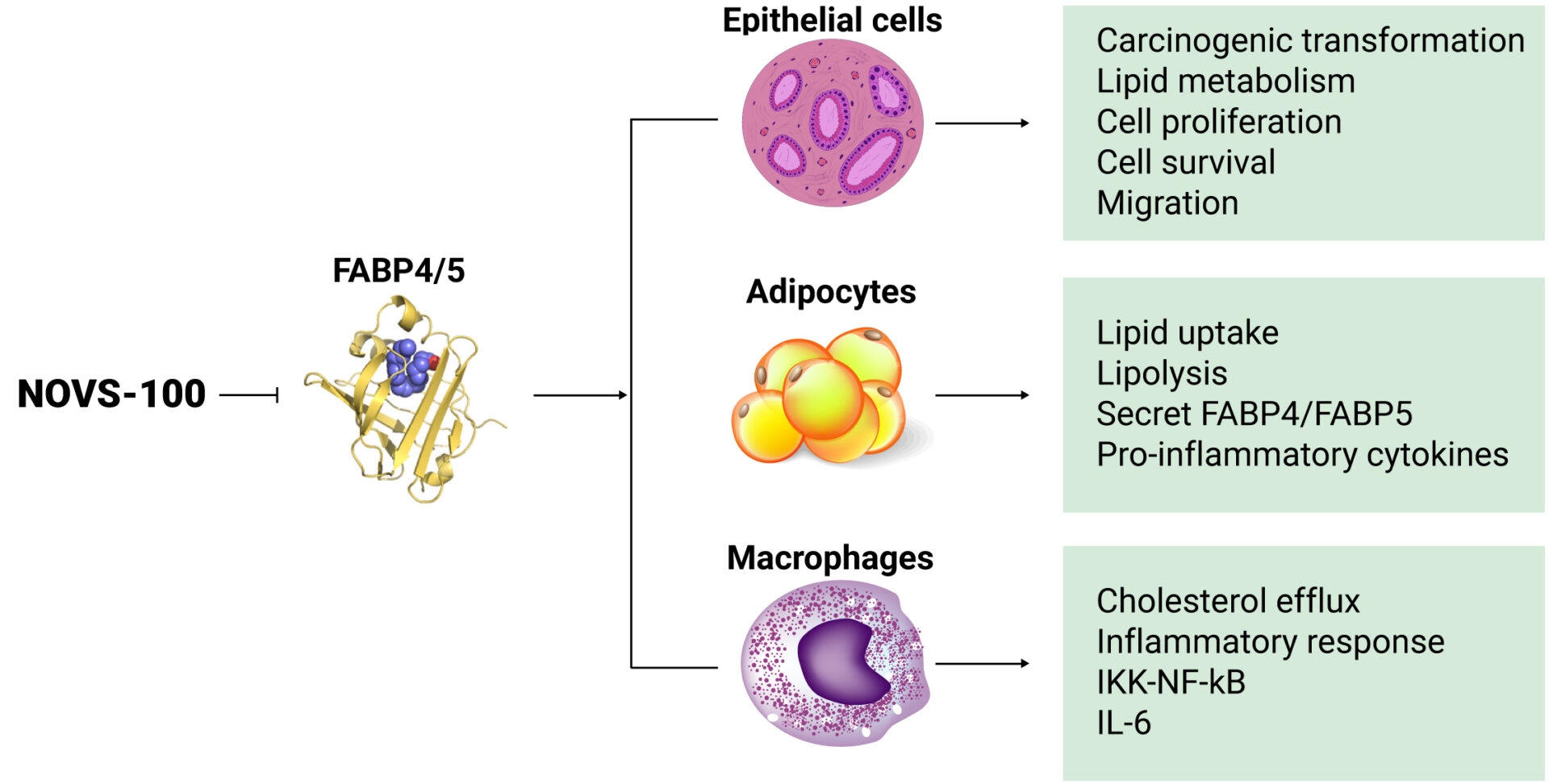Celloram is developing two lines of selective small molecule drugs to be used for cancer, metabolic disorders and chronic inflammation. By decoding molecular pathways involved in progression of these diseases we were able to identify novel molecular targets and design specific inhibitors to block their activities. CLM-022 is a triterpenoid derivative that targets the inflammasome machinery and NOVS-100 is a novel inhibitor of fatty acid binding proteins 4 and 5.
CLM-022
CLM-022 is Celloram’s unique synthetic pentacyclic triterpenoid derivative of a natural triterpenoid quinone methide. CLM-022 exhibits potent anti-inflammatory and antioxidant properties achieved by suppressing activation of the NLRP3 inflammasome machinery and inhibiting oxidation-induced cellular stress. NLRP3 inflammasomes are intracellular protein complexes that function as a key component of the innate immune response and contribute to the development of various human diseases, such as autoinflammatory disorders, metabolic syndrome, and neurodegeneration. Most recently, the NLRP3 inflammasome has been identified as a key mediator of resistance to immune checkpoint inhibitors used in cancer immunotherapy. CLM-022 has emerged as a new therapeutic, effectively targeting the NLRP3 complex.
Inflammatory bowel disease (IBD)
As many as 5 million people worldwide live with a form of chronic inflammation affecting the small and large intestines known as inflammatory bowel disease, or ‘IBD’. The two major forms of IBD, including ulcerative colitis (UC) and Crohn’s disease (CD), are chronic, relapsing inflammatory conditions that are associated with significant risks for various co-morbidities, decreased quality of life, and disease-associated illnesses including cancer. Evidence suggests that the pathogenesis of IBD involves misdirected regulation of mucosal-associated immune cells and an imbalance of various pro-inflammatory cytokines.
Despite the tremendous advances made in recent years in IBD therapeutics, many patients are primarily unresponsive, and even among responders, most patients will ultimately develop resistance to many of the currently available treatments. In addition, current IBD medications are associated with significant risks for infection and have not reduced the elevated risk for cancer that affects this patient population. Thus, there is a significant unmet medical need for new drugs or drug combinations with more favorable safety profiles with greater capacity to suppress the inflammatory process of IBD and to reduce the risk for cancer in patients affected by these conditions.
Celloram’s unique lead synthetic triterpenoid, CLM-022, is designed to effectively block key cellular signaling pathways that promote inflammation. CLM-022 is safe, orally bioavailable, and has demonstrated potential to add significantly to our armamentarium of agents for chronic inflammatory and neurodegenerative disorders, and as an adjunct to immune-based therapies for cancer.
NOVS-100
NOVS-100 is Celloram’s lead small molecule inhibitor of fatty acid-binding proteins 4 and 5 (FABP4, FABP5). FABP4/5 signaling pathways are critically important in maintaining lipid homeostasis in adipocytes, macrophages, and epithelial cells. Elevated levels of FABP4/5 trigger excess lipid uptake and storage, chronic inflammation, and carcinogenic transformation making these proteins attractive targets to treat metabolic and inflammatory disorders and different types of cancer.
Triple Negative Breast Cancer (TNBC)
TNBC accounts for 10-20% of all breast cancer cases diagnosed worldwide, amounting to almost 200,000 cases/year. This is the most aggressive and deadly breast cancer subtype with patients having higher chances to develop metastasis within the first 3 to 5 years after diagnosis, leading to worse relapse-free survival and overall survival compared with patients with non-TNBC subtypes. The term triple-negative breast cancer refers to the fact that the cancer cells are lacking the 3 most commonly targeted biomarkers considered for breast cancer treatment: estrogen receptor, progesterone receptor, and human epidermal growth factor receptor.
The lack of definitive prognostic markers and selective targets for therapy makes the treatment and management of TNBC a significant clinical problem. The global TNBC treatment market is segmented into doxorubicin, cyclophosphamide, paclitaxel, docetaxel, carboplatin/cisplatin and others. Yet, even patients that respond well to chemotherapy frequently develop resistance and experience a visceral or brain metastasis that leads to poor overall survival. Several targeted agents have been investigated in clinical trials so far but did not demonstrate a clear survival benefit.
Our lead compound NOVS-100 exhibits anti-carcinogenic activities specifically against TNBC by inhibition of FABP5 in the tumors and the tumor microenvironment. The role of FABP5 in lipid metabolism makes it essential for tumor cells to maintain their high energy demands as well as promote inflammation in the microenvironment of the tumors. NOVS-100 specifically targets TNBC cells that overexpress FABP5 and suppress their growth. NOVS-100 is non-toxic to non-tumor cells and has high bioavailability.
Atherosclerosis
Atherosclerosis is a chronic inflammatory disease of the arteries and is the underlying cause of about 50% of all deaths in westernized society. Atherosclerotic cardiovascular disease (ASCVD) is principally a lipid-driven process initiated by the accumulation of low-density lipoprotein and remnant lipoprotein particles and an active inflammatory process in focal areas of arteries. ASCVD usually results in heart attacks, stroke and peripheral arterial disease.
As atherosclerosis is a chronic inflammatory condition based on both dyslipidemia and inflammation, even when dyslipidemia is controlled, the risk of atherosclerosis remains. Initiation and progression of the atherosclerotic lesions are the result of highly complex processes, and many aspects of atherogenesis remain incompletely understood. Furthermore, in most cases, mechanistic insights have yet to be translated into therapeutic approaches.
Celloram’s compound NOVS-100 provides a potent therapeutic strategy against atherosclerosis and obesity by its ability to target the two main mechanisms leading to the development of these diseases, lipid metabolism and inflammation. This activity of NOVS-100 is achieved by the dual inhibition of FABP4 and FABP5. It is known that both FABP4 and FABP5 are critically important in the development of metabolic syndrome through their distinct actions in adipocytes and macrophages, which they may directly access as abundant, circulating plasma proteins.















